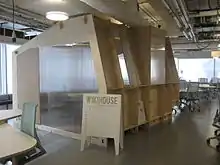WikiHouse
WikiHouse is an open-source project for designing and building houses.[1][2] It endeavours to democratise and simplify the construction of sustainable, resource-light dwellings.[1][2][3][4][5] The project was initiated in the summer of 2011 by Alastair Parvin and Nick Ierodiaconou of 00, a London-based strategy and design practice, in collaboration with Tav of Espians, James Arthur now with 00 and Steve Fisher of Momentum Engineering.[6][7] It was launched at the Gwangju Design Biennale in Gwangju, South Korea.[6][8][9] The project has since grown to become a worldwide community of contributors.[10]

Concept

WikiHouse enables users to download Creative Commons-licensed files from its online library, customize them using SketchUp, and then use them to create jigsaw puzzle-like pieces out of plywood with a CNC router.[1][7] Construction of WikiHouse structures requires no special parts because the cut pieces of wood snap together with wedge and peg connections inspired by classical Korean architecture.[11][12] The frame of a WikiHouse can be assembled in less than a day by people with no formal training in construction.[11] The frame must then be finished with cladding, insulation, wiring, and plumbing before it can be inhabited.[2][12] The WikiHouse project is maintained by Open Systems Lab.[13]
History
.jpg.webp)
After winning a cash prize at TEDGlobal in June 2012, the project invested the prize money into a partnership with the Brazilian youth mobilization project Dharma and the analysis agency BrazilIntel to build WikiHouses in the poorest favelas of Rio de Janeiro, Brazil.[4] The goal of the partnership, dubbed WikiHouseRio, is to provide a single "maker lab" where one CNC router can be shared by the community while also allowing and encouraging community members to develop their own designing and building skills.[4][6] The WikiHouse team plans to eventually create similar maker labs in other underdeveloped communities around the world.[4] There are also plans to use WikiHouses as disaster-relief housing in earthquake-prone countries such as Haiti, Japan, and New Zealand.[3]
By December 2013, while there were no inhabited WikiHouses, there were a few completed prototypes in addition to a usable walkers' shelter in Fridaythorpe, England.[12] These WikiHouses are single-story, square-shaped structures with sloped roofs and small foundations that measure about 175 square feet (16.3 m2).[2] By 2015, several additional WikiHouses had been built, including the following buildings and at the following events:
- Maker Faire 2013 in Queens[14]
- WikiHouse 4.0 at the London Design Festival[15]
- 150-square-foot (14 m2) FOUNDhouse microhouse[16][17]
- WikiHouse at MAKlab in Glasgow[18]
- Chop Shop in western Scotland[19]
- Space Craft Systems project in New Zealand[20]
- WikiSHED fork[21][22]
- WikiHouse at the 2015 Vienna Open[23]
Impact
Media reaction to WikiHouse has focused largely on the experimental nature of the project,[1][2] comparisons with IKEA furniture,[2][12] and the potential difficulty in finding and costs of using CNC routers.[1][4] American science fiction author Bruce Sterling also gave a review of the WikiHouse design, describing it favorably as a dwelling "I could quite likely build and inhabit, personally".[24]
See also
References
- LaBarre, Suzanne (25 August 2011). "WikiHouse, An Online Building Kit, Shows How To Make A House In 24 Hours". Co.Design. Fast Company, Inc. Retrieved 17 December 2013.
- Kingsley, Jeremy (22 February 2012). "The WikiHouse Revolution". Slate. Retrieved 17 December 2013.
- Borgobello, Bridget (15 May 2012). "WikiHouse: Get ready to design, "print" and construct your own home!". Gizmag. Retrieved 17 December 2013.
- Isaacson, Betsy (1 March 2013). "WikiHouse Democratizes Design For Inexpensive, Easily Built Homes". The Huffington Post. Retrieved 17 December 2013.
- "The Emergence of Open Construction Systems: A Sustainable Paradigm in the Construction Sector?". Journal of Futures Studies: 67–84. 2019-01-14. doi:10.6531/jfs.201812_23(2).0005. Retrieved 2019-01-22.
- Parvin, Alastair; Nick Ierodiaconou (22 June 2012). "A House and Home for the 99%". CITY2.0. TED Conferences, LLC. Retrieved 17 December 2013.
- Firth, Peter; Thomas Rees (5 August 2011). "Grand Designs: Open-source platform comes to housing". LifeStyle:News:Global. Retrieved 17 December 2013.
- Hicks, Jesse (17 August 2011). "WikiHouse promises printable homes, work for the world's idle CNC routers". Engadget. Retrieved 17 December 2013.
- "00:/ at TED2013". 00:/Blog. 00:/. 27 February 2013. Retrieved 20 December 2013.
- "WikiHouse Community". WikiHouse. Retrieved 20 December 2013.
- McNicoll, Arion (5 August 2013). "How to build your home from scratch for $35,000". CNN.com. Retrieved 17 December 2013.
- Goodwins, Rupert (16 December 2013). "Meet The People Who Want To Print A Home In A Day". Popular Science. Retrieved 17 December 2013.
- "Projects". Open Systems Labs. Retrieved August 30, 2018.
- "WikiHouse Gives Architecture to the People". Global Lighting. 23 January 2014. Retrieved 13 April 2015.
- Stott, Rory (September 22, 2014). "WikiHouse Unveils World's First Two-Storey Open-Source House at London Design Festival". ArchDaily. Retrieved November 2, 2019.
- "FOUNDhouse". FOUNDhouse. Retrieved 13 April 2015.
- "WikihouseUS/Vermont-Microhouse". GitHub. Retrieved 13 April 2015.
- Bain, Duncan (15 July 2013). "MAKLab's Wikihouse: Day One". Open Source Architecture blog. Retrieved 13 April 2015.
- "Wikihouse". Chop Shop. 23 October 2014. Retrieved 13 April 2015.
- "Space Craft: developing WikiHouse in New Zealand". Space Craft Systems. Retrieved 13 April 2015.
- "Wikihouse Project". SketchThis. 2 January 2014. Retrieved 13 April 2015.
- "WikihouseUS/Alex-Wikished". GitHub. Retrieved 13 April 2015.
- "Vienna Open". Vienna Open, Verlag Neue Arbeit. Retrieved 29 November 2015.
- Sterling, Bruce (2 August 2011). "Architecture Fiction: WikiHouse". Wired. Retrieved 17 December 2013.